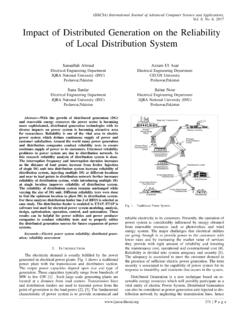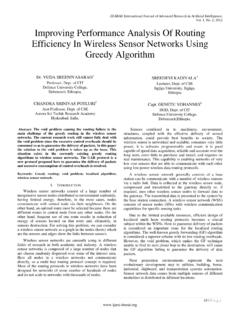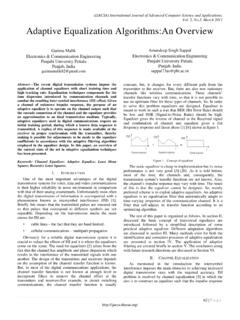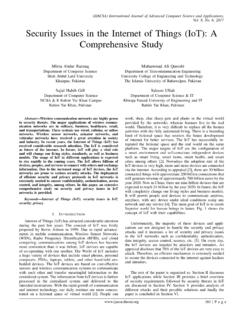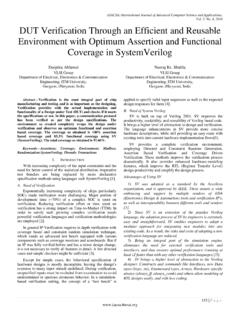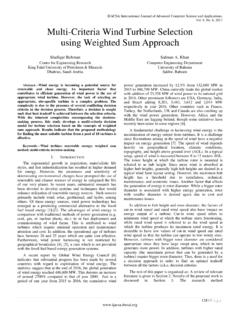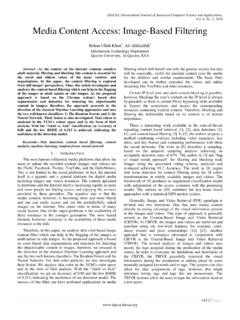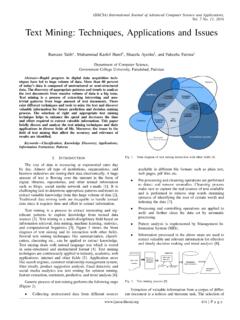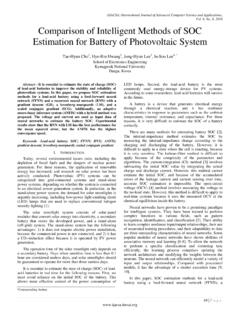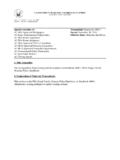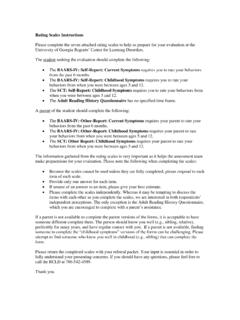Transcription of Wireless LAN Security Threats & Vulnerabilities
1 (IJACSA) International Journal of Advanced Computer Science and Applications, Vol. 5, No. 1, 2014 176 | P a g e Wireless LAN Security Threats & Vulnerabilities : A Literature ReviewMd. Waliullah Dept. of Computer Science & Engineering, Daffodil International University, Dhaka, Bangladesh Diane Gan School of Computing and Mathematical Science University of Greenwich, London, UK Abstract Wireless LANs are everywhere these days from home to large enterprise corporate networks due to the ease of installation, employee convenience, avoiding wiring cost and constant mobility support. However, the greater availability of Wireless LANs means increased danger from attacks and increased challenges to an organization, IT staff and IT Security professionals. This paper discusses the various Security issues and Vulnerabilities related to the IEEE Wireless LAN encryption standard and common Threats /attacks pertaining to the home and enterprise Wireless LAN system and provide overall guidelines and recommendation to the home users and organizations.
2 Keywords WLAN; IEEE ; WIDS/WIPS; MITM; DoS; SSID; AP; WEP; WPA/WPA2 I. INTRODUCTION Over the last twelve years, Wireless LAN s have matured and really reshaped the network landscape. is now rapidly replacing Ethernet as the method of network access. The rapid proliferations of mobile devices has led to a tremendous need for Wireless local area networks (WLAN), deployed in various types of locations, including homes, educational institutions, airports, business offices, government buildings, military facilities, coffee shops, book stores and many other venues. Besides, the facilities of flexibility and mobility of Wireless devices has been attracted by most organizations and consumers all over the world. Low cost of hardware and user friendly installation procedures allow anyone to set up their own Wireless network without any specialist knowledge of computer networks.
3 However, the increased development of Wireless LAN has increased the potential Threats to the home user, small businesses and the corporate world. Unlike a wired network, a WLAN uses radio frequency transmission as the medium for communication. This necessarily exposes layer 1 and layer 2 to whoever can listen into the RF ranges on the network. Wireless insecurity has been a critical issue since Wired Equivalent Privacy (WEP), an IEEE standard Security algorithm for Wireless networks, was compromised [1]. To address the significant Security flaws in the WEP standard, the Wi-Fi alliance developed the standard, called Wi-Fi Protected Access (WPA) and WPA2 [1]. However, many researchers have shown that the IEEE standard cannot prevent eavesdropping, various denial of service attacks including de-authentication and disassociation attacks.
4 Moreover, s pre-shared key mode of WEP for flexibility and backward compatibility has made it easier for most hackers to perform a Dictionary and Brute force attack [2]. Recently, a scanning experiment based on London conducted by the Security firm Sophos has revealed that more than one in four Wi-Fi networks in London are poorly secured or not secured at all [3]. Of 100,000 Wi-Fi networks detected on a 90 Km route, 8% of the Wi-Fi networks detected used no encryption at all. This figure excludes intentionally open networks such as coffee shops, hotels and Wi-Fi hotspots. Approximately, 9% of Wi-Fi networks detected were using default network names such as default or a supplier name enabling the hacker to break passwords more easily. More importantly, the experiment revealed that 19% of the Wi-Fi networks detected used obsolete WEP as the encryption standard which has already proved to be easily cracked within a second, using readily available hacking tools [3].
5 So, the Security of a Wireless LAN still remains the top concern in the home and corporate network. This paper discusses the Vulnerabilities and Security issues pertaining to the IEEE Security standard and describes major well known attack/ Threats to the home and enterprise Wireless LAN system. The remainder of the paper is organised as follows. A brief overview of WLANs are outlined in section II. Related work is presented in section III. The common Vulnerabilities and Security issues pertaining to the IEEE Security standard and WLAN are discussed in section IV. This is followed by an over view of the common Threats /attacks on WLAN technology. Common guidelines and an overall recommendation is presented in section VI, and a conclusion is outlined in section VII. II. OVERVIEW OF WLAN An access point (AP) and a network interface card (NIC) are the two basic components of a WLAN.
6 An AP typically connects the Wireless clients or stations to each other by means of antenna and then connects to the wired backbone through a standard Ethernet cable. A NIC normally connects a Wireless station to the AP in the Wireless LAN [4]. Any devices that have the ability to communicate with networks are called a station laptops, printers, media servers, smartphones, IPhones, Windows mobile handsets, VoIP phones etc. All stations operate in two ways, either in ad-hoc mode, where stations are connected to each other, or in infrastructure mode, where stations are communicating with each other via the access points to reach some other network [5]. (IJACSA) International Journal of Advanced Computer Science and Applications, Vol. 5, No. 1, 2014 177 | P a g e Companies install as many access points as it takes to cover an entire building or even a campus.
7 The whole network is configured with the same network name to act as one huge Wireless network, which is called an extended service set identifier (ESSID) or a standard service set identifier (SSID). For example, if an IPhone wants to connect to a WLAN, it starts by scanning all channels; sends a probe request and listens for beacon frames that are sent by access points to advertise themselves. Then, it compares all those beacons and probe responses to the desired SSID and selects the best available access point. Finally, the IPhone will send an authenticating packet and will associate the request to that access point by establishing a 4-way handshake mechanism. Once the IPhone is associated and authenticated it can send and receive data using that Wireless network [5]. III. RELATED WORK Sheldon, Weber, Yoo and Pan [1] described how the Wireless LAN encryption standards such as WEP, WPA/WPA2 are vulnerable to attack.
8 They presented some of the attacks on encryption standards such as Chop-chop attack, Brute force, Beck-Tews, Halvorsen-Haugen and the hole 196 attacks etc. Wang, Srinivasan, and Bhattacharjee [2] proposed a 3-way handshake model instead of the usual 4 way handshake method for the protocol. They suggested how their alternative method can effectively prevent denial of service (DoS) attacks including de-authentication, disassociation and memory/CPU DoS attacks. Souppaya and Scarfone [6] discussed the need for Security concerns and these should be applied from the configuration design stage to implementation and evaluation through to the maintenance stage of the WLAN. They provided some general guidelines and recommendations in order to reduce the Vulnerabilities and prevent the most common Threats . Pan Feng [4] suggested that more than 70% of the WLAN Security issues are due to human factors, such as data theft by acquaintances or colleagues.
9 He addressed that remaining 30% of Security Threats are technology related. Reddy, Rijutha, Ramani, Ali, and Reddy [7] demonstrated how WEP can be cracked by freely available open source software tools such as Netstumbler, Ministubler, Airopeek, Kismat, Cain etc. They have mainly focused on securing WLANs by realizing miscellaneous Threats and Vulnerabilities associated with WLAN standards and have used ethical hacking to try to make these more secure. Li and Garuba [8] and Deng Shiyang [9] discuss various encryption standards relating to WLAN, their Vulnerabilities and Security flaws. Stimpson et al [10] describes war driving techniques as a useful tool for assessing Security and Vulnerabilities of home Wireless networks. However, none of the above researchers has elaborately presented WLAN Security Vulnerabilities , Threats and general guidelines/recommendations for securing them.
10 Realizing the Vulnerabilities , understanding the most common Threats and providing general guidelines and recommendation in order to protect WLAN network and make them more secure for the home user and for enterprise networks is the aim of this paper. IV. WLAN Vulnerabilities Wireless LANs have gained much more popularity than wired networks because of their flexibility, cost-effectiveness and ease of installation. However, the increasing deployment of WLANs presents the hacker or cracker with more opportunities. Unlike wired networks, WLANs transmit data through the air using radio frequency transmission or infrared. Current Wireless technology in use enables an attacker to monitor a Wireless network and in the worst case may affect the integrity of the data. There are a number of Security issues that presents the IT Security practitioner, system administrator securing the WLAN with difficulties [11].
